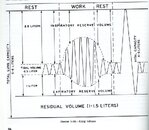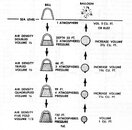Hmmm. . . what are you going to do if you have the OOA problem on the inhale?
I always dive with a 19cuft pony, no CESA for me
Okay, let's say that you have a regulator first stage failure which prevents any air coming to you, and affects your octopus too (say, the actuating pin under the diaphragm in the first stage breaks, preventing any air from coming to the second stage). So you are out-of-air (OOA) without any source to you, and you are at 132 feet of sea water (5 atmospheres absolute pressure). This means that the air in your lungs is five times as dense as it is at the surface.
Now look at the diagram from the
March, 1970 U.S. Navy Diving Manual. Note that most people's vital capacity is 5-6 liters of air in their lungs. If you were diving relaxed, and using only your tidal volume of air, upon exhalation you would still have about 2-2.5 liters of air in your lungs. If you were working hard, and breathing heavily, you would have about 1.5 to 2 liters of air in your lungs (there is a "residual volume" in your lungs, even when you exhale fully).
So what to do? Ascend! As you ascend, the air expands in your lungs due to the lessening of water pressure. Let's say you only have that 1.5 to 2 liters of residual air in your lungs, and you feel you have "no air." You actually do, as your lungs have not collapsed, but the feeling is still there. You ascend to 99 feet. Here, the absolute pressure is 4 atmospheres, not five that you started with at 132 feet. The 1.5 to 2 liters of air in your lungs have expanded with the lessening pressure, and you don't have that "empty" feeling anymore. That initial 1.5-2 liters of air in your lungs has expanded to 1.87-2.5 liters of air. Knowing that you need to exhale air as it expands, you open your larnx and mouth, and if excess air is there it can come out.
As you continue your ascent, you get to 66 feet, and your lungs are feeling full. At this point, you need to exhale the excess air. That initial 1.5-2 liters of air has expanded and is now expanded to 2.5-3.3 liters of air. This is within your normal breath.
But as you continue toward the surface, the air continues to expand, and that initial 1.5-2 liters of air will be 3.75-5 liters of air, and you are at risk of over-pressuring you alveoli (air sacs) if you don't exhale at 33 feet.
As you proceed toward the surface, you really need to get rid of a lot of air, as that initial 1.5-2 liters of air in your lungs is now expanding hugely to 7.5-10 liters of air.
We used to teach this stuff to divers, but no more, as we are now equipment-reliant (with pony bottles, redundant systems, etc.). But it is easily possible to do a CESA from 132 feet from a complete exhale. While I have not done it, I have simulated an ascent from 75 feet (by removing my scuba at the pool at 16 feet depth, and swimming an estimated 75 feet to the "surface" horizontally blowing air all the way. I'm confident, as a current diver who's been diving since 1959, and who under LA County instructor Roy France had to do a CESA from 35 feet in Yaquina Bay in 1963, and from 33 feet from a simulated submarine exit at the U.S. Naval School for Underwater Swimmers, Key West, Florida in 1967, that I can do a 132 foot CESA. And, by the way, I'm now 72.5 years old.
Take a look at the diagram below from Bill Barada's manual,
Let's Go Diving, Illustrated Diving Manual, published in 1962 by U.S. Divers Company, to see this relationship in pressure/volume for diving.
SeaRat
NAUI Instructor #2710 (1973, Retired)
PS, I choose 132 feet as I am a sport diver, don't do technical diving, and will not do decompression diving unless special precautions are taken (evac plan, recompression chamber available, etc.).






